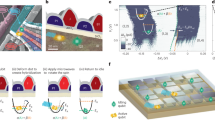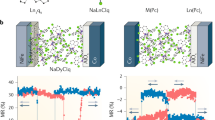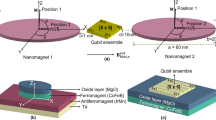Abstract
Spins in solids or in molecules possess discrete energy levels, and the associated quantum states can be tuned and coherently manipulated by means of external electromagnetic fields. Spins therefore provide one of the simplest platforms to encode a quantum bit (qubit), the elementary unit of future quantum computers. Performing any useful computation demands much more than realizing a robust qubit—one also needs a large number of qubits and a reliable manner with which to integrate them into a complex circuitry that can store and process information and implement quantum algorithms. This ‘scalability’ is arguably one of the challenges for which a chemistry-based bottom-up approach is best-suited. Molecules, being much more versatile than atoms, and yet microscopic, are the quantum objects with the highest capacity to form non-trivial ordered states at the nanoscale and to be replicated in large numbers using chemical tools.
This is a preview of subscription content, access via your institution
Access options
Access Nature and 54 other Nature Portfolio journals
Get Nature+, our best-value online-access subscription
$29.99 / 30 days
cancel any time
Subscribe to this journal
Receive 12 print issues and online access
$259.00 per year
only $21.58 per issue
Buy this article
- Purchase on Springer Link
- Instant access to full article PDF
Prices may be subject to local taxes which are calculated during checkout




Similar content being viewed by others
References
Christou, G., Gatteschi, D., Hendrickson, D. & Sessoli, R. Single-molecule magnets. MRS Bulletin 25, 66–71 (2000).
Milios, C. J. et al. A record anisotropy barrier for a single-molecule magnet. J. Am. Chem. Soc. 129, 2754–2755 (2007).
Ishikawa, N., Sugita, M., Ishikawa, T., Koshihara, S.-Y. & Kaizu, Y. Lanthanide double-decker complexes functioning as magnets at the single-molecular level. J. Am. Chem. Soc. 125, 8694–8695 (2003).
Aldamen, M. A., Clemente-Juan, J. M., Coronado, E. & Martí-Gastaldo, C. Gaita-Ariño, A. Mononuclear lanthanide single-molecule magnets based on polyoxometalates. J. Am. Chem. Soc. 130, 8874–8875 (2008).
AlDamen, M. A. et al. Mononuclear lanthanide single molecule magnets based on the polyoxometalates [Ln(W5O18)2]9− and [Ln(β2-SiW11O39)2]13− [Ln(III) = Tb, Dy, Ho, Er, Tm, and Yb]. Inorg. Chem. 48, 3467–3479 (2009).
McAdams, S. G., Ariciu, A.-M., Kostopoulos, A. K., Walsh, J. P. S. & Tuna, F. Molecular single-ion magnets based on lanthanides and actinides: design considerations and new advances in the context of quantum technologies. Coord. Chem. Rev. 346, 216–239 (2017).
Escalera-Moreno, L., Baldoví, J. J., Gaita-Ariño, A. & Coronado, E. Spin states, vibrations and spin relaxation in molecular nanomagnets and spin qubits: a critical perspective. Chem. Sci. 9, 3265–3275 (2018).
Guo, F.-S. et al. A dysprosium metallocene single-molecule magnet functioning at the axial limit. Angew. Chem. Int. Ed. 56, 11445–11449 (2017).
Goodwin, C. A. P., Ortu, F., Reta, D., Chilton, N. F. & Mills, D. P. Molecular magnetic hysteresis at 60 kelvin in dysprosocenium. Nature 548, 439–442 (2017).
Guo, F.-S. et al. Magnetic hysteresis up to 80 kelvin in a dysprosium metallocene single-molecule magnet. Science 362, 1400–1403 (2018).
Zurek, W. H. Decoherence, einselection, and the quantum origins of the classical. Rev. Mod. Phys. 75, 715–775 (2003).
Schleich, W. P. Quantum physics: engineering decoherence. Nature 403, 256–257 (2000).
Takahashi, S. et al. Decoherence in crystals of quantum molecular magnets. Nature 476, 76–79 (2011).
Devoret, M. H. & Schoelkopf, R. J. Superconducting circuits for quantum information: an outlook. Science 339, 1169–1173 (2013).
Monroe, C. & Kim, J. Scaling the ion trap quantum processor. Science 339, 1164–1169 (2013).
Hanson, R., Dobrovitski, V. V., Feiguin, A. E., Gywat, O. & Awschalom, D. D. Coherent dynamics of a single spin interacting with an adjustable spin bath. Science 320, 352–355 (2008).
Steger, M. et al. Quantum information storage for over 180 s using donor spins in a 28Si “semiconductor vacuum”. Science 336, 1280–1283 (2012).
Stamp, P. C. E. & Gaita-Ariño, A. Spin-based quantum computers made by chemistry: hows and whys. J. Mater. Chem. 19, 1718–1730 (2008).
Clemente-Juan, J. M., Coronado, E. & Gaita-Ariño, A. Magnetic polyoxometalates: from molecular magnetism to molecular spintronics and quantum computing. Chem. Soc. Rev. 41, 7464–7478 (2012).
Aromí, G., Aguilà, D., Gamez, P., Luis, F. & Roubeau, O. Design of magnetic coordination complexes for quantum computing. Chem. Soc. Rev. 41, 537–546 (2012).
Sessoli, R. Toward the quantum computer: magnetic molecules back in the race. ACS Cent. Sci. 1, 473–474 (2015).
Gaita-Ariño, A. et al. Coherence and organisation in lanthanoid complexes: from single ion magnets to spin qubits. Inorg. Chem. Front. 3, 568–577 (2016).
Graham, M. J., Zadrozny, J. M., Fataftah, M. S. & Freedman, D. E. Forging solid-state qubit design principles in a molecular furnace. Chem. Mater. 29, 1885–1897 (2017).
Jelezko, F., Gaebel, T., Popa, I., Gruber, A. & Wrachtrup, J. Observation of coherent oscillations in a single electron spin. Phys. Rev. Lett. 92, 076401 (2004).
Doherty, M. W. et al. The nitrogen-vacancy colour centre in diamond. Phys. Rep. 528, 1–45 (2013).
Scarabelli, D., Trusheim, M., Gaathon, O., Englund, D. & Wind, S. J. Nanoscale engineering of closely-spaced electronic spins in diamond. Nano Lett. 16, 4982–4990 (2016).
Pla, J. J. et al. A single-atom electron spin qubit in silicon. Nature 489, 541–545 (2012).
Pla, J. J. et al. High-fidelity readout and control of a nuclear spin qubit in silicon. Nature 496, 334–338 (2013).
Muhonen, J. T. Storing quantum information for 30 seconds in a nanoelectronic device. Nat. Nanotechnol. 9, 986–991 (2014).
Ardavan, A. et al. Will spin-relaxation times in molecular magnets permit quantum information processing?. Phys. Rev. Lett. 98, 057201 (2007).
Wedge, C. J. et al. Chemical engineering of molecular qubits. Phys. Rev. Lett. 108, 107204 (2012).
Bertaina, S. et al. Quantum oscillations in a molecular magnet. Nature 453, 203–206 (2008).
Warner, M. et al. Potential for spin-based information processing in a thin-film molecular semiconductor. Nature 503, 504–508 (2013).
Bader, K. et al. Room temperature quantum coherence in a potential molecular qubit. Nat. Commun. 5, 5304 (2014).
Zadrozny, J. M., Niklas, J., Poluetkov, O. G. & Freedman, D. E. Millisecond coherence time in a tunable molecular electronic spin qubit. ACS Cent. Sci. 1, 488–492 (2015).
Atzori, M. et al. Room-temperature quantum coherence and Rabi oscillations in vanadyl phthalocyanine: toward multifunctional molecular spin qubits. J. Am. Chem. Soc. 138, 2154–2157 (2016).
Shiddiq, M. et al. Enhancing coherence in molecular spin qubits via atomic clock transitions. Nature 531, 348–351 (2016).
Martínez-Pérez, M. J. et al. Gd-based single-ion magnets with tunable magnetic anisotropy: molecular design of spin qubits. Phys. Rev. Lett. 108, 247213 (2012).
Jenkins, M. D. et al. Coherent manipulation of three-qubit states in a molecular single-ion magnet. Phys. Rev. B 95, 064423 (2017).
Godfrin, C. et al. Operating quantum states in single magnetic molecules: implementation of Grover’s quantum algorithm. Phys. Rev. Lett. 119, 187702 (2017).
Morello, A., Stamp, P. C. E. & Tupitsyn, I. S. Pairwise decoherence in coupled spin qubit networks. Phys. Rev. Lett. 97, 207206 (2006).
Gómez, S. et al. Origin of slow magnetic relaxation in Kramers ions with nonuniaxial anisotropy. Nat. Commun. 5, 4300 (2014).
Escalera-Moreno, L., Suaud, N., Gaita-Ariño, A. & Coronado, E. Determining key local vibrations in the relaxation of molecular spin qubits and single-molecule magnets. J. Phys. Chem. Lett. 8, 1695–1700 (2017).
Lunghi, A., Totti, F., Sessoli, R. & Sanvito, S. The role of anharmonic phonons in under-barrier spin relaxation of single molecule magnets. Nat. Commun. 8, 14620 (2017).
Bertaina, S. et al. Rare-earth solid-state qubits. Nat. Nanotechnol. 2, 39–42 (2007).
Baibekova, E. et al. Coherence times and Rabi oscillations in CaWO4:Cr5+ crystal. J. Magn. Res 209, 61–68 (2011).
Fataftah, M. S., Zadrozny, J. M., Rogers, D. M. & Freedman, D. E. A mononuclear transition metal single-molecule magnet in a nuclear spin-free ligand environment. Inorg. Chem. 53, 10716–10721 (2014).
Cardona-Serra, S., Gaita-Ariño, A., Stamenova, M. & Sanvito, S. Theoretical evaluation of [VIV(α-C3S5)3]2– as nuclear-spin-sensitive single-molecule spin transistor. J. Phys. Chem. Lett. 8, 3056–3060 (2017).
Pedersen, K. S. et al. Toward molecular 4f single-ion magnet qubits. J. Am. Chem. Soc. 138, 5801–5804 (2016).
Baldoví, J. J. et al. Rational design of single-ion magnets and spin qubits based on mononuclear lanthanoid complexes. Inorg. Chem. 51, 12565–12574 (2012).
Zadrozny, J. M., Gallagher, A. T., Harris, T. D. & Freeman, D. E. A porous array of clock qubits. J. Am. Chem. Soc. 139, 7089–7094 (2017).
Hinkley, N. et al. An atomic clock with 10–18 instability. Science 341, 1215–1218 (2013).
Cardona-Serra, S. et al. Lanthanoid single-ion magnets based on polyoxometalates with a 5-fold symmetry: the series [LnP5W30O110]12− (Ln3+ = Tb, Dy, Ho, Er, Tm, and Yb). J. Am. Chem. Soc. 134, 14982–14990 (2012).
Barenco, A. et al. Elementary gates for quantum computation. Phys. Rev. A 52, 3457 (1995).
Lehmann, J. et al. Spin qubits with electrically gated polyoxometalate molecules. Nat. Nanotechnol. 2, 312–317 (2007).
Ferrando-Soria, J. et al. A modular design of molecular qubits to implement universal quantum gates. Nat.Commun. 7, 11377 (2016).
Salinas, J. et al. Molecules designed to contain two weakly coupled spins with photoswitchable spacer. Chem. Eur. J. 23, 13648–13659 (2017).
Vandersypen, L. M. K. & Chuang, I. L. NMR techniques for quantum control and computation. Rev. Mod. Phys. 76, 1037 (2004).
Ardavan, A. et al. Engineering coherent interactions in molecular nanomagnet dimers. npj Quantum Inf. 1, 15012 (2015).
Fernández, A. et al. Making hybrid [n]-rotaxanes as supramolecular arrays of molecular electron spin qubits. Nat. Commun. 7, 10240 (2016).
Aguilà, D. et al. Synthesis and properties of a family of unsymmetric dinuclear complexes of LnIII (Ln = Eu, Gd, Tb). Inorg. Chem. 49, 6784–6786 (2010).
Luis, F. et al. Molecular prototypes for spin-based CNOT and SWAP quantum gates. Phys. Rev. Lett. 107, 117203 (2011).
Aguilà, D. et al. Heterodimetallic [LnLn′] lanthanide complexes: toward a chemical design of two-qubit molecular spin quantum gates. J. Am. Chem. Soc. 136, 14215–14222 (2014).
Leuenberger, M. N. & Loss, D. Quantum computing with molecular magnets. Nature 410, 789–793 (2001).
Moreno-Pineda, E., Godfrin, C., Balestro, F., Wernsdorfer, W. & Ruben, M. Molecular spin qudits for quantum algorithms. Chem. Soc. Rev. 47, 501–513 (2018).
Thiele, S. et al. Electrically driven nuclear spin resonance in single-molecule magnets. Science 344, 1135–1138 (2014).
Moreno-Pineda, E., Damjanovic, M., Fuhr, O., Wernsdorfer, W. & Ruben, M. Nuclear spin isomers: engineering a Et4N[DyPc2] spin qudit. Angew. Chem. Int. Ed. 56, 9915–9919 (2017).
Atzori, M. et al. A two-qubit molecular architecture for electron-mediated nuclear quantum simulation. Chem. Sci. 9, 6183–6192 (2018).
Hussain, R. et al. Coherent manipulation of a molecular Ln-based nuclear qudit coupled to an electron qubit. J. Am. Chem. Soc. 140, 9814–9818 (2018).
Gibney, E. Quantum computer quest. Nature 516, 24 (2014).
Komijani, D. et al. Radical-lanthanide ferromagnetic interaction in a TbIII bis-phthalocyaninato complex. Phys. Rev. Mater. 2, 024405 (2018).
Vincent, R., Klyatskaya, S., Ruben, M., Wernsdorfer, W. & Balestro, F. Electronic read-out of a single nuclear spin using a molecular spin transistor. Nature 488, 357–360 (2012).
Godfrin, C. et al. Electrical read-out of a single spin using an exchange-coupled quantum dot. ACS Nano 11, 3984–3989 (2017).
Cardona-Serra, S. & Gaita-Ariño, A. Vanadyl dithiolate single molecule transistors: the next spintronic frontier? Dalton Trans. 47, 5533–5537 (2018).
Wallraff, A. et al. Strong coupling of a single photon to a superconducting qubit using circuit quantum electrodynamics. Nature 431, 162 (2004).
Schoelkopf, J. & Girvin, S. M. Wiring up quantum systems. Nature 451, 664 (2008).
Majer, J. et al. Coupling superconducting qubits via a cavity bus. Nature 449, 443–447 (2007).
Jenkins, M. D. et al. A scalable architecture for quantum computation with molecular nanomagnets. Dalton Trans. 45, 16682 (2016).
Mergenthaler, M. et al. Strong coupling of microwave photons to antiferromagnetic fluctuations in an organic magnet. Phys. Rev. Lett. 119, 147701 (2017).
Ghirri, A. et al. Coherently coupling distinct spin ensembles through a high-Tc superconducting resonator. Phys. Rev. A 93, 063855 (2016).
Bonizzoni, C. et al. Coherent coupling between vanadyl phthalocyanine spin ensemble and microwave photons: towards integration of molecular spin qubits into quantum circuits. Sci. Rep. 7, 13096 (2017).
Jenkins, M. D. et al. Nanoscale constrictions in superconducting coplanar waveguide resonators. Appl. Phys. Lett. 105, 162601 (2014).
Jenkins, M. D. et al. Coupling single-molecule magnets to quantum circuits. New J. Phys. 15, 095007 (2013).
Rosaleny, L. E. et al. Peptides as versatile platforms for quantum computing. J. Phys. Chem. Lett. 9, 4522–4526 (2018).
Acknowledgements
This work has been supported by the COST Action MolSpin on Molecular Spintronics (Project 15128) and QUANTERA (SUMO project). E.C. and A.G.A. acknowledge the EU (ERC Advanced Grant Mol-2D 788222, ERC Consolidator Grant DECRESIM 647301), the Spanish MINECO (grants MAT2017-89993-R and CTQ2017-89528-P cofinanced by FEDER and Excellence Unit María de Maeztu MDM-2015-0538), and the Generalitat Valenciana (Prometeo Program of Excellence). A.G.A. acknowledges funding by the MINECO (Ramón y Cajal Program). F.L. acknowledges the Spanish MINECO (grant MAT2015-68204-R), the Gobierno de Aragón (grant E98-MOLCHIP). S.H. acknowledges support from the NSF (grant DMR-1610226), the Air Force Office of Scientific Research (AOARD Contract No. FA2386-17-1-4040) and the Department of Energy (grant DE-SC0019330). Work performed at the NHMFL was supported by the NSF (DMR-1644779) and by the State of Florida. We acknowledge S. Cardona-Serra and O. Roubeau for preparation of Fig. 1 and Fig. 2a–d, and Fig. 4, respectively.
Author information
Authors and Affiliations
Corresponding authors
Ethics declarations
Competing interests
The authors declare no competing interests.
Additional information
Publisher’s note: Springer Nature remains neutral with regard to jurisdictional claims in published maps and institutional affiliations.
Rights and permissions
About this article
Cite this article
Gaita-Ariño, A., Luis, F., Hill, S. et al. Molecular spins for quantum computation. Nat. Chem. 11, 301–309 (2019). https://doi.org/10.1038/s41557-019-0232-y
Published:
Issue Date:
DOI: https://doi.org/10.1038/s41557-019-0232-y
This article is cited by
-
Slow magnetic relaxation in a europium(II) complex
Nature Communications (2024)
-
Emissive brightening in molecular graphene nanoribbons by twilight states
Nature Communications (2024)
-
Multi-valued Quantum Neurons
International Journal of Theoretical Physics (2024)
-
Reversible spin-optical interface in luminescent organic radicals
Nature (2023)
-
Quantum face recognition protocol with ghost imaging
Scientific Reports (2023)



